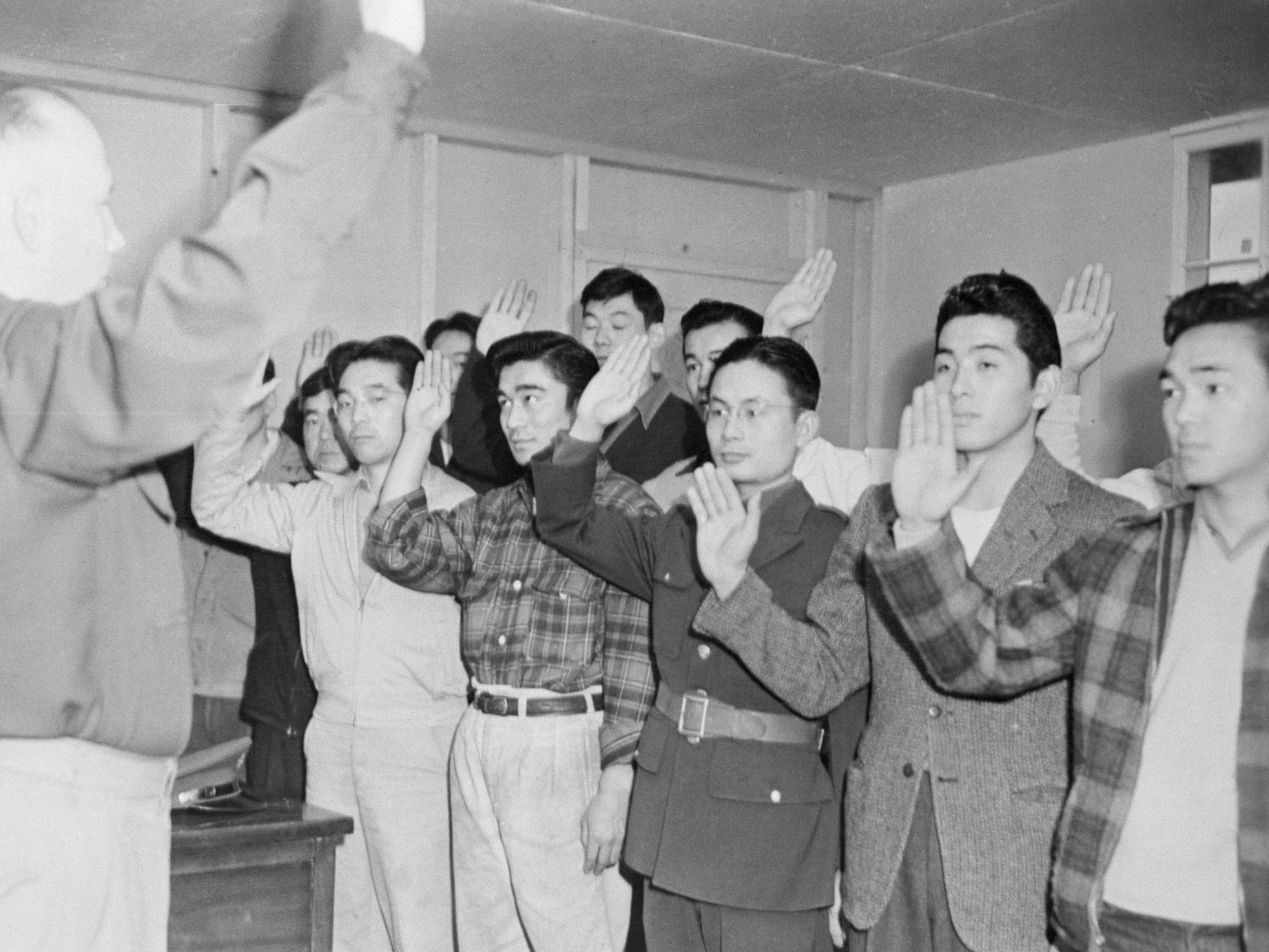Business Insider
Japanese-Americans are sworn into the US Army at the Granada Colorado Relocation Center in January 1943.
Bettmann via Getty Images
Shortly after the Pearl Harbor attack, the US began sending Japanese-Americans to internment camps.
More than 120,000 people of Japanese ancestry were eventually relocated to the remote camps.
The US Army also recruited soldiers from the camps, relying on them to be translators in the Pacific.
Two months after Japan attacked Pearl Harbor and the US entered World War II, President Franklin Roosevelt issued Executive Order 9066, authorizing the forced relocation of West Coast residents deemed a threat to national security and eventually leading to their internment.
The order did not name a specific ethnic group, but within weeks, the US military began detaining Japanese-Americans. More than 120,000 men, women, and children of Japanese ancestry — two-thirds of them US citizens — were eventually relocated to camps in remote areas, where the majority lived under guard for the rest of the war.
The message behind the policy was as racist and oppressive as it was clear: Japanese immigrants, known as “Issei,” and their American-born offspring, or “Nisei,” were “enemy aliens” who could not be trusted.
The Gila River War Relocation Center southeast of Pheonix, where more than 13,000 Japanese-Americans were interned between 1942 and 1945.
Courtesy of Bruce Henderson
But the US military also knew that to fight Japan effectively, it needed soldiers who spoke Japanese.
As a result, the Army’s Military Intelligence Service trained several thousand American soldiers of Japanese descent at stateside language schools and rushed them to the Pacific to serve as interpreters, translators, and interrogators.
Some 33,000 Nisei served in the US military during the war, most in Europe and North Africa, where their segregated, all-Nisei units were recognized for their formidable fighting.
Yet 4,000 Nisei also served in the Pacific, often under top-secret circumstances. Some were already in the Army when they were recruited for the special training. Others volunteered directly from the barbed-wire compounds of their internment camps.
Japanese-American internees at the Jerome War Relocation Center in southeastern Arkansas.
Courtesy of Bruce Henderson
Attached to combat units, Nisei serving as linguists fought alongside US soldiers and Marines in major battles across the Pacific and China-Burma-India theaters. They earned medals and praise from generals, but they also experienced racism and vitriol.
These Nisei troops, long overlooked, are the subject of bestselling author Bruce Henderson’s newest book, “Bridge to the Sun: The Secret Role of the Japanese Americans Who Fought in the Pacific in World War II.” As Henderson writes, they “fought two wars simultaneously: one against their ancestral homeland; the other against racial prejudice at home.”
Henderson learned of the Nisei while researching his previous book, which documents the service of Jewish boys who fled Europe and joined the US Army to fight the Nazis. He spoke with Insider about the wartime service of Nisei in the Pacific, and why, nearly eight decades years later, it is important to bring their experiences to light.
Japanese-American Nisei soldiers at US Army Military Intelligence Service language school.
Courtesy of Bruce Henderson
Insider: What were some of the similarities between the Ritchie Boys – Jews who returned to fight Germany – and the Nisei in the Pacific?
Henderson: They were both trained in secret by [the Army’s Military Intelligence Service] for identical missions in opposite theaters of war. Each endured prejudice and overcame distrust to become huge assets in our fight against our enemies.
Because they knew the language, the culture, the customs of our enemies better than anyone, they were able to gather valuable intelligence that not only helped win battles — and this is what really came out in my research — but that saved lives.
Not only American lives but also lives of Japanese soldiers and civilians caught up in the war, because they were able to, for example, convince Japanese civilians to, say, leave a cave when these civilians thought it might be better to blow themselves up in this cave than be captured by the Americans, because they had been inundated with propaganda as to what we’d do to them.
President Harry S. Truman presents the Presidential Distinguished Unit Citation banner to the 442nd Regimental Combat Team in July 1946.
Bettmann via Getty Images
Insider: What ultimately compelled you to write “Bridge to the Sun” and highlight the stories of six Nisei serving in the Pacific?
Henderson: I’ve written about the war in the Pacific, but I didn’t know about these military intelligence units being sent over there. I had no idea this took place. So to me it was a real revelation.
I was interested in the dynamic, like what did the GIs over there think of these 10-man Nisei groups that came in? How were they treated? What did they think about? If they had been captured by the enemy, how would they have been treated? It wasn’t unlike what the Jewish Ritchie Boys had been thinking about if they had been captured by the Nazis.
But the root of my interest, and it got even bigger as I did the research, was that we’re in a country that too often pre-judges based on factors like race, religion, ethnicity, countries of origin, things like that. And the wartime service of these Nisei in the Pacific — against their ancestral homeland, and certainly their parents’ homeland — is really dramatic and inspirational.
Not many people know that we had Japanese-Americans fighting the Pacific war. The story of these Japanese-Americans has really been lost in history.
Japanese-American Nisei soldiers take the US Army oath.
Courtesy of Bruce Henderson
Insider: How did the US Army recruit these soldiers?
Henderson: A couple of different ways.
The very first Japanese language school was started by the Army a months before Pearl Harbor. They had about 60 people in the class in San Francisco, and it was done because there was a small cadre of military intelligence officers who had served in Japan in the ’30s, and they knew how complicated the language was — particularly the reading and the writing, but also conversationally.
With all of the tensions building in the Pacific, they realized that if we did go to war, it would be tough to not have teams in the field that had mastery of Japanese. So they had started this very small school with Nisei who were already in the Army.
Insider: How did Japan’s surprise attack on Pearl Harbor impact MIS’s initiative and approach?
Henderson: They realized there had to be this great expansion. They started this new school in Minnesota. It couldn’t be on the coast because of the anti-Japanese laws there. Everyone had to be off the coast and put in these camps, and that included soldiers as well.
But they couldn’t recruit the number of people they needed for these units just from the soldiers already in the Army, so they actually went out and started recruiting them at internment camps, which was one of the more incredulous things in my mind: Here you are in a camp with your family, and you’re there because you’re not to be trusted, and here come two officers from the US Army saying “We need you. We want you. We want you to volunteer for the Army so we can train you to go over to help us out in the war against Japan.”
Anti-Japanese sentiment was rampant in the US following Japan’s attack on Pearl Harbor.
Courtesy of Bruce Henderson
Insider: I can’t imagine how that must have felt for some of these families: being asked to send their sons to war to defend the same country that was uprooting and interning them. What were the experiences of the Nisei you wrote about?
Henderson: [Young Nisei] were Americans first and foremost. They wanted to participate in this war, and a lot had to get the permission of their parents.
In all of the stories that I saw, it was that the parents, even though they still love Japan and had relatives back there and everything, they told their children, who were born in America: You are American … This is your homeland, and you should fight.
So they got the permission of their immigrant parents to participate in this war, and their parents were very proud.
Nisei soldiers at the US Army Military Intelligence Service’s language school.
Courtesy of Bruce Henderson
Insider: Language was clearly a key part of these roles as interpreters, translators, and interrogators. What did training entail?
Henderson: The training was going to be a year-long program, and what actually came as a surprise for the Army was that not every Japanese-American spoke Japanese fluently … They were born and raised here.
But they found that the “Kibei” – Japanese-Americans who were sent to Japan to go to boarding school for some period of time and then returned to America – were the most valuable. They knew the language and culture, so those guys were recruited especially.
The program that was initially going to be a year was shortened to six months because there was this pressure to get these teams into the units that were being sent to the Pacific. You can’t in six months go from not knowing any Japanese to being fluent.
What they were learning mostly in the training were military terms, Japanese Army organization, how to interrogate a prison of war — what you can and can’t do — and our own military terms and movements and things like that. It was a pretty short program.
Insider: What happened next?
Henderson: They [typically] formed these 10- or 12-man teams … and that team stuck together and went overseas and were attached to either a headquarters or a regiment or a division, or in some cases they were split up to spread out the language capability in the field.
By the end of the war, MIS graduated 6,000 of these Japanese-language interpreters, translators, and interrogators.
A US Army Nisei soldier gives water to a child in Okinawa.
Courtesy of Bruce Henderson
Insider: What were some of the experiences and contributions of the Nisei you featured?
Henderson: Of those three things that they were meant to do, probably what turned out to be the most valuable was the interpreting of the written documents that were found in the field of battle.
Japanese soldiers were not only allowed to, but apparently it was really part of their customs, to write a daily journal, a diary about what was going on. And of course, our guys were specifically told not to do that, and for good reason, because if you’re captured, then the enemy has your diary.
But these guys would write in their journals details about their unit, whether they were hungry, how many were left, what their plans were. And so this stuff was coming off of the field of battle for these language teams to go through and interpret, and they got a lot of valuable information about order of battle and enemy movements.
US Army Nisei soldiers interrogating a Japanese prisoner of war.
Courtesy of Bruce Henderson
Insider: What about the translators and interrogators?
Henderson: The translators and interrogators were also valuable, but in a lot of the battles in the Pacific the Japanese were simply not surrendering, so it was somewhat limited as to what they could do in the field in terms of interrogating prisoners.
But there definitely were times when they did get hold of somebody valuable. One prisoner was a codeman who knew the Japanese Army code, radio code, so when they found that out and reported it to their superiors, this guy was taken off the island and flown to Pearl Harbor to be immediately debriefed by the code guys there to see if he could help at all in terms of breaking some of the war codes.
Kazuo Komoto and first lady Eleanor Roosevelt at a hospital in Fiji in August 1943.
Courtesy of Bruce Henderson
Insider: What stories stand out when it comes to the discrimination and prejudices these soldiers faced?
Henderson: Of the guys that I chose to write about, there was only one still alive when I started my research, Kazuo Komoto. He won the first Purple Heart awarded to a Japanese-American soldier in the war. He was wounded in the Solomon Islands and he ended up in the hospital being visited by Eleanor Roosevelt.
After he got out of the hospital, stateside, he got on a bus and he went to visit his family, who were in Arizona in a relocation camp. He … gets off a stop early in this town, and he wants to take some fresh meat in to his family. He understands that their diet is limited and everything.
So he’s in uniform, and he goes into this small grocery store, to the meat counter, and is looking at the meat. And the butcher says, “I don’t sell to no Japs.” Komoto says, “I’m not a Jap. I’m an American.” The long and short is that Komoto was not going to leave there without getting what he came for.
Gen. Frank Merrill, commander of Merrill’s Marauders, with Japanese-American soldiers.
Courtesy of Bruce Henderson
Insider: What about discrimination within the Army?
Henderson: I have a scene in the book where this 10-man Nisei unit is aboard a troop ship with 2,000 others. For a while they’re kept out of sight, in their own space, their own quarters, and then finally there’s this rumor that we have Japanese prisoners of war aboard and let’s go get them and throw ’em overboard. So somebody decided we better get these guys up and introduce them as troops.
Both in that scene and throughout, there’s an initial presentation, if you will, of this special elite language team that we’re really going to need. They’re really important to our mission, and they’re going to not only help us as GIs stay alive but do our jobs and win our fights. They were looked at as being really valuable.
There were scenes where even a commanding general would say, “Sakamoto, you stick with me.” And by the way, [Second Lt. Tom] Sakamoto was credited with saving a general’s life in one of the battles and even made the newspapers as saving this general’s life.
That doesn’t mean that every individual soldier didn’t have his own thoughts and feelings, I’m sure. But these guys were attached to the Marines. They were at Iwo Jima. They were in Okinawa. They were in Burma. They were in the Solomon Islands.
Every iconic battle in the Pacific that was fought had these guys there, and it was secret at the time and for many, many decades after.
Grant Hirabayashi, right, with a group of Korean women.
Courtesy of Bruce Henderson
Insider: What can we learn from these soldiers’ experiences?
Henderson: Anti-immigrant sentiments are still too prevalent in this country today. I really hope that this book will reflect the untold story of the courage and the sacrifice of these young Nisei men. I hope it will serve as a reminder of the true definition of patriotism.
I came across a quote from [one of the soldiers in the book] Grant Hirabayashi, who after his retirement became a popular speaker. He said that Americanism has nothing to do with a place of origin or color of skin. It has everything to do with spirit and conviction and love of freedom. And the true definition of patriotism, Grant believed, was a citizen fulfilling his right and responsibility.
His direct quote was, “Our constitution is vulnerable. We have to be very vigilant and protect our liberty and freedom.” If that quote isn’t as valid today as it was when he said it back in the 1990s and lived it in the 1940s, I don’t know what is.
Katie Sanders is a journalist based in New York City. Her reporting has brought her to prisons, JDate, the CIA, and the White House. Follow her at @KatieSSanders












